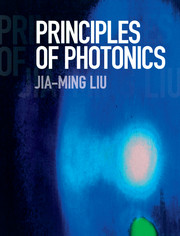Book contents
- Frontmatter
- Dedication
- Contents
- Preface
- Partial List of Symbols
- 1 Basic Concepts of Optical Fields
- 2 Optical Properties of Materials
- 3 Optical Wave Propagation
- 4 Optical Coupling
- 5 Optical Interference
- 6 Optical Resonance
- 7 Optical Absorption and Emission
- 8 Optical Amplification
- 9 Laser Oscillation
- 10 Optical Modulation
- 11 Photodetection
- Appendix A Symbols and Notations
- Appendix B SI Metric System
- Appendix C Fundamental Physical Constants
- Appendix D Fourier-Transform Relations
- Index
- References
3 - Optical Wave Propagation
Published online by Cambridge University Press: 05 August 2016
- Frontmatter
- Dedication
- Contents
- Preface
- Partial List of Symbols
- 1 Basic Concepts of Optical Fields
- 2 Optical Properties of Materials
- 3 Optical Wave Propagation
- 4 Optical Coupling
- 5 Optical Interference
- 6 Optical Resonance
- 7 Optical Absorption and Emission
- 8 Optical Amplification
- 9 Laser Oscillation
- 10 Optical Modulation
- 11 Photodetection
- Appendix A Symbols and Notations
- Appendix B SI Metric System
- Appendix C Fundamental Physical Constants
- Appendix D Fourier-Transform Relations
- Index
- References
Summary
NORMAL MODES OF PROPAGATION
The propagation of an optical wave is governed by Maxwell's equations. The propagation characteristics depend on the optical property and the physical structure of the medium. They also depend on the makeup of the optical wave, such as its frequency content and its temporal characteristics. In this chapter, we discuss the basic propagation characteristics of a monochromatic optical wave in three basic categories of medium: an infinite homogeneous medium, two semi-infinite homogeneous media separated by an interface, and an optical waveguide defined by a transverse structure. Some basic effects of dispersion and attenuation on the propagation of an optical wave are discussed in Sections 3.6 and 3.7.
The optical property of a medium at a frequency of ω is fully described by its permittivity ε(ω), which is a tensor for an anisotropic medium but reduces to a scalar for an isotropic medium. For a homogeneous medium, ε(ω) is a constant of space; for an optical structure, it is a function of space variables. Without loss of generality, we designate the z coordinate axis to be the direction of optical wave propagation in an isotropic medium; thus the longitudinal axis of an optical waveguide that is fabricated in an isotropic medium is the z axis. For this reason, ε(ω) has only transverse spatial variations that are functions of the transverse coordinates, which are x and y in the rectilinear coordinate system, or Φ and r in the cylindrical coordinate system. We use the rectilinear coordinates for our general discussion. The exception is optical wave propagation in an anisotropic crystal, for which the natural coordinate system is that defined by its principal axes but an optical wave does not have to propagate along its principal z axis.
For the following discussion in this section, we consider propagation in an isotropic medium, which is not necessarily homogeneous in space. The wave propagates in the z direction, and the possible inhomogeneity characterizing the optical structure is described by a scalar permittivity ε(x, y), as illustrated in Fig. 3.1. If the medium is homogeneous, then ε(x, y) = ε is a constant of space, as shown in Fig. 3.1(a).
- Type
- Chapter
- Information
- Principles of Photonics , pp. 66 - 140Publisher: Cambridge University PressPrint publication year: 2016

